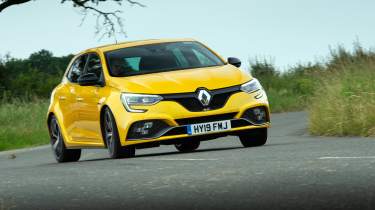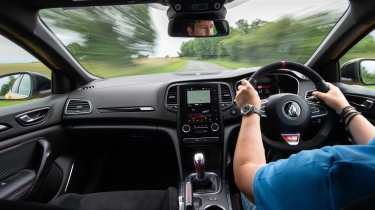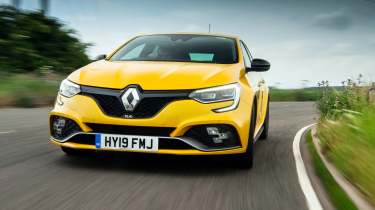Renault Mégane RS Trophy Fast Fleet test – 13,000 miles in the swansong hot hatch
Despite initial reservations, the Liquid Yellow hatch won over its keeper after 8 months on the evo Fast Fleet
The RS Mégane is an interesting machine, because it consistently divided opinion – even at evo, where our admiration for Renault Sport’s back catalogue rivals that of our obsession with Porsche 911s. That’s why prior to becoming custodian of HY19 FMJ I felt conflicted, torn between a long-standing love for fast Renaults but rattled by a less than starry-eyed first impression of the RS Meg from eCoty 2018.
I suspected the Mégane needed extended time and miles to reveal itself fully, but having been in the same boat with a Clio 200 Turbo some years ago – only to find the more I drove it the less I liked it – the Liquid Yellow RS Mégane Trophy had a lot to prove.
> Renault Sport Megane R26.R (2009): the most significant hot hatch of the last 25 years
Helpfully I loved its looks. I’ve always tended to prefer three-door hot hatchbacks so it bugs me that five-doors are taking over the world, but I have to say that of all the C-segment hot hatches I think the Mégane wears the additional doors very well. Shape and stance were both spot-on, while the dramatic front and rear lights created unmistakable graphics at night.
More reviews
Those sharp looks were backed up by a fine engine, the turbocharged 1.8-litre four-pot being an absolute cracker in the Trophy’s uprated, 296bhp state of tune. Smooth, punchy and genuinely characterful, it was a real highlight of the car and easily returned 30-plus mpg unless caned. The manual transmission’s shift quality was a bit snaggly, but still enriched the driving experience enough for me not to wish I’d opted for the EDC paddleshift ’box and the further 15lb ft of torque that comes with it.
The uprated Brembo front brakes had great power and a progressive response, which coupled to well-spaced pedals meant heel-and-toe downshifts were easy to execute. The Trophy package also included Cup suspension, which stiffened things up considerably. Low-speed ride was combative, but it didn’t bother me and I loved the greater body control and fabulous sense of focus it brought to every journey.
The Trophy also came with a mechanical limited-slip diff, which further ramped-up the aggression and no-nonsense delivery. Hard acceleration through the first three gears would have the nose pulling with lines and camber, but the way it dug for traction and found bite out of corners was really something.
I only tried the Mégane on track a couple of times. It acquitted itself well, but also underlined to me how the four-wheel-steering system clouded the feel. Amplified agility arguably has a place on the road as you’re rarely near the absolute limit of the tyre or chassis, and the Renault 4Control system is more natural feeling than some. But having driven the fabulous two-wheel-steer Trophy-R on road and track, I’m convinced that all the RS Méganes would have purer, more detailed feel and a greater sense of consistency if they followed suit.
On the practical side of things, I can’t think of many other full-on driver’s cars that would fulfil a day-to-day multipurpose role so well as the Trophy. The optional Alcantara-trimmed seats sat 20mm lower and were super-supportive yet extremely comfortable, even on one-hit drives to Le Mans and Switzerland. The boot swallowed big bags with ease, and folding down the rear seats created a 296bhp van for speedy Ikea missions and tip runs. Rear legroom and headroom was decent and the back seats were actually habitable rather than an afterthought.
The infotainment system had its quirks and the touchscreen ‘buttons’ could be hard to prod when on the move thanks to the jiggly ride. The satnav was intuitive to, er, navigate, while the Bose stereo gave a rich tone and had enough muscle to overcome the road and exhaust noise. Speaking of which, I never tired of the fruity pops and crackles in Sport mode.
One thing I did wish was easier to operate was the RS mode. There’s a button on the dash which flicks between Neutral and Sport, but you had to enter a sub-menu on the touchscreen to access Comfort, Track or the driver-configurable Personal mode.
With long service intervals it’s rare to experience the dealer networks during a long-term loan these days, but less than a month before it went back to Renault I booked the Trophy in for its 12,000-mile service. I used my local dealer, Smiths Renault in Peterborough, who were excellent from the moment they picked up the phone.
In addition to the scheduled 12k service (£248.14), a health check revealed the front brake pads were 60 per cent worn and front tyres down to 3.6mm on both inner shoulders. Given the car already had a replacement set of tyres at 8k miles (with no track work after that) the Meg clearly liked to wring the most from its bespoke Bridgestone rubber.
Like the two previous-generation Mégane RSs I’ve run, this one proved faultless, with an impressive resistance to squeaks and rattles and blessed with a genuinely solid feel. It didn’t use a drop of oil and never threw a warning light.
I began my tenure with the Mégane wondering if I could ever fall for it as completely as I did its simpler and more analogue predecessors. Now it’s gone I’m left with the sense that it came very close to capturing their satisfyingly no-nonsense character, while bringing a bandwidth that far exceeded theirs.
It was clearly a challenge for Renault Sport to engineer its DNA into a larger, more complex hatchback, yet enough of that grit remained to keep this old-school fan loyal. There were a few things I’d like to see improved, but after eight months and 13,000 miles I’d still choose a Renault Sport Mégane over any of its rivals, if it was still around...
| Date acquired | June 2019 |
| Duration of test | 8 months |
| Total test mileage | 12,875 |
| Overall mpg | 30.6 |
| Costs | £783 (tyres), £248.14 (service) |
| Purchase price | £35,435 |
| Value today | £25,000 |
This story was first featured in evo issue 272.







